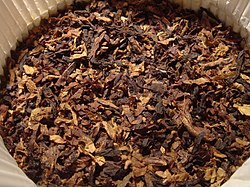Smokeless tobacco keratosis
| Smokeless tobacco keratosis | |
|---|---|
| Synonyms | Snuff dipper's lesion, Snuff pouch, Tobacco pouch keratosis |
| Pronounce | N/A |
| Specialty | N/A |
| Symptoms | White or grayish patches in the oral mucosa |
| Complications | Potential for oral cancer |
| Onset | Gradual, associated with use of smokeless tobacco |
| Duration | Variable, may persist with continued tobacco use |
| Types | N/A |
| Causes | Use of smokeless tobacco products |
| Risks | Increased risk of oral cancer, periodontal disease |
| Diagnosis | Clinical examination, biopsy if necessary |
| Differential diagnosis | Leukoplakia, Oral lichen planus, Candidiasis |
| Prevention | Cessation of smokeless tobacco use |
| Treatment | Discontinuation of tobacco use, regular monitoring |
| Medication | N/A |
| Prognosis | Good with cessation, risk of malignancy if continued |
| Frequency | Common among users of smokeless tobacco |
| Deaths | N/A |
Smokeless tobacco keratosis is a condition that affects the oral mucosa, or the lining of the mouth, due to the use of smokeless tobacco products. It is also known as tobacco pouch keratosis, snuff dipper's keratosis, or snuff dipper's lesion.
Causes[edit]
Smokeless tobacco keratosis is caused by the chronic use of smokeless tobacco products, such as chewing tobacco and snuff. These products contain a variety of harmful substances, including nicotine, carcinogens, and irritants, which can cause changes in the oral mucosa.
Symptoms[edit]
The primary symptom of smokeless tobacco keratosis is the development of white or gray patches on the oral mucosa, typically in the area where the tobacco product is held. These patches may have a wrinkled or corrugated appearance, and they may be thickened or hardened. Other symptoms can include discomfort, pain, or a burning sensation in the mouth.
Diagnosis[edit]
Diagnosis of smokeless tobacco keratosis is typically made through a clinical examination of the oral cavity. The healthcare provider will look for characteristic changes in the oral mucosa, such as white or gray patches. A biopsy may be performed to confirm the diagnosis and to rule out other conditions, such as oral cancer.
Treatment[edit]
The primary treatment for smokeless tobacco keratosis is to stop using smokeless tobacco products. This can lead to a complete resolution of the lesions in most cases. If the lesions do not resolve after cessation of tobacco use, or if they show signs of malignant transformation, further treatment may be necessary, such as surgery or radiation therapy.
Prevention[edit]
The best way to prevent smokeless tobacco keratosis is to avoid the use of smokeless tobacco products. Public health initiatives aimed at reducing the use of these products can play a key role in prevention.
See also[edit]
| Tobacco |
|---|
|
|
Ad. Transform your life with W8MD's Budget GLP-1 injections from $75


W8MD offers a medical weight loss program to lose weight in Philadelphia. Our physician-supervised medical weight loss provides:
- Weight loss injections in NYC (generic and brand names):
- Zepbound / Mounjaro, Wegovy / Ozempic, Saxenda
- Most insurances accepted or discounted self-pay rates. We will obtain insurance prior authorizations if needed.
- Generic GLP1 weight loss injections from $75 for the starting dose.
- Also offer prescription weight loss medications including Phentermine, Qsymia, Diethylpropion, Contrave etc.
NYC weight loss doctor appointmentsNYC weight loss doctor appointments
Start your NYC weight loss journey today at our NYC medical weight loss and Philadelphia medical weight loss clinics.
- Call 718-946-5500 to lose weight in NYC or for medical weight loss in Philadelphia 215-676-2334.
- Tags:NYC medical weight loss, Philadelphia lose weight Zepbound NYC, Budget GLP1 weight loss injections, Wegovy Philadelphia, Wegovy NYC, Philadelphia medical weight loss, Brookly weight loss and Wegovy NYC
|
WikiMD's Wellness Encyclopedia |
| Let Food Be Thy Medicine Medicine Thy Food - Hippocrates |
Medical Disclaimer: WikiMD is not a substitute for professional medical advice. The information on WikiMD is provided as an information resource only, may be incorrect, outdated or misleading, and is not to be used or relied on for any diagnostic or treatment purposes. Please consult your health care provider before making any healthcare decisions or for guidance about a specific medical condition. WikiMD expressly disclaims responsibility, and shall have no liability, for any damages, loss, injury, or liability whatsoever suffered as a result of your reliance on the information contained in this site. By visiting this site you agree to the foregoing terms and conditions, which may from time to time be changed or supplemented by WikiMD. If you do not agree to the foregoing terms and conditions, you should not enter or use this site. See full disclaimer.
Credits:Most images are courtesy of Wikimedia commons, and templates, categories Wikipedia, licensed under CC BY SA or similar.
Translate this page: - East Asian
中文,
日本,
한국어,
South Asian
हिन्दी,
தமிழ்,
తెలుగు,
Urdu,
ಕನ್ನಡ,
Southeast Asian
Indonesian,
Vietnamese,
Thai,
မြန်မာဘာသာ,
বাংলা
European
español,
Deutsch,
français,
Greek,
português do Brasil,
polski,
română,
русский,
Nederlands,
norsk,
svenska,
suomi,
Italian
Middle Eastern & African
عربى,
Turkish,
Persian,
Hebrew,
Afrikaans,
isiZulu,
Kiswahili,
Other
Bulgarian,
Hungarian,
Czech,
Swedish,
മലയാളം,
मराठी,
ਪੰਜਾਬੀ,
ગુજરાતી,
Portuguese,
Ukrainian

